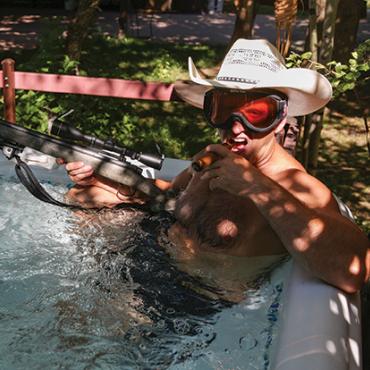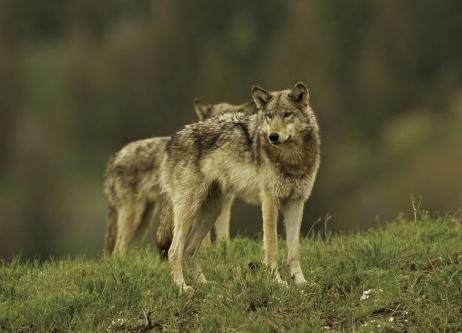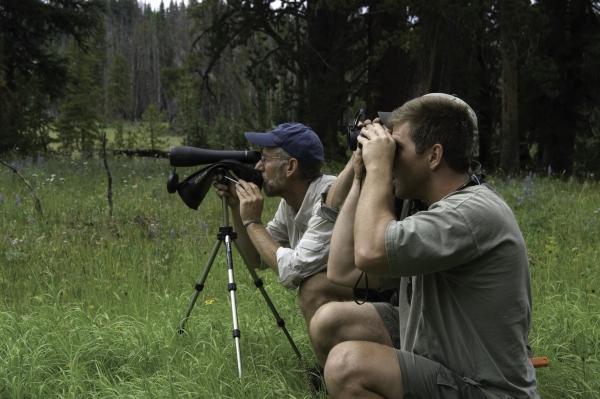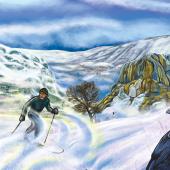Chasing the Wolf
“Wolves!” It’s the only word Doug can get out. Excited, out of breath, he takes a knee and we all gather round. Between gasps he fills us in. “I went… to take a leak… right over there… there’s wolves… right over there!”
We dash to our packs and grab binoculars. Doug turns, beckoning. Single-file, we hustle through the wooded campsite toward a clearing on the far side. At the treeline, Doug crouches and signals for us to come alongside.
As we hunker in the brush, Doug points to a small hillside some 50 yards distant. And there they are, two of the largest, most magnificent wolves I’ve ever seen. Well over 100 pounds, tall and lean, they lounge in the grass. “That’s the alpha male and female,” says Tim, one of our guides, though the fact is obvious by the pair’s size and demeanor. They look like royalty: stately, self-possessed, with formidable strength and power lurking beneath a placid exterior.
“There’s another one,” someone whispers, pointing to a dark wolf sitting under a tree. Farther down the slope lies a young pair—one black, one grey—pawing one another languidly. To the right, another three adults, sound asleep. We gradually pick out more among the sporadic trees and variegated grasses; all told, perhaps a dozen wolves, scattered around the meadow. By dumb luck, we’ve stumbled upon a Yellowstone wolf pack in the middle of siesta—and we’re within a stone’s throw of every one. Binos cling to faces as we watch one of the Park’s top predators, our fevered whispers floating through the damp evening air.
Two days earlier, our group of seven set out from Soda Butte, across the Lamar Valley, to learn about wolves. From the beginning, our Yellowstone Forever Institute guides Tim and Greg made it clear: we probably wouldn’t see Canus lupis. We were here to study the grey wolf—tracks, behavior, its place in the ecosystem, etc.—and this was the best possible classroom. But the chances of actually running across the iconic Yellowstone mammal, while on foot and in a large group? Tim shrugged. “It could happen, sure,” he said. “But don’t get your hopes up.”
Class began with a wolf kill. About a mile into our hike, as we followed a buffalo trail toward the river, Greg paused and stooped over the remains of an elk. His long hair, tan skin, and muscular legs told of years spent outside, following wild animals through rugged terrain. Like an over-caffeinated CSI agent, he reconstructed the kill scene, showing us paw prints, teeth marks, and broken sagebrush. He played out the scene: across the valley, a pack of five or six wolves had singled out an older cow from the herd, chased her across the open sage flat, and taken her down here. Scavengers followed, picking the skeleton clean after the wolves had their fill. “I never knew a dead elk could tell such a detailed story,” my friend Peter observed.
We made camp on a high bank above Cache Creek. Some of the group snoozed in the late-afternoon heat, while Peter and I stripped down for a quick dip in the stream. With plenty of light left, Cache Creek’s upper reaches looked enticing—we grabbed our binos and set out. Tracks in the soft banks suggested recent visits from elk, coyotes, and otters. Tim pointed out various flora along the stream—monkshood, chokecherry, northern bedstraw—while Greg regaled us with stories of Yellowstone’s amazing geologic past.
Our turnaround point was Death Gulch, a parched drainage spilling down from Mirror Plateau. On the burned-out slopes above, blackened lodgepoles gave way to ashen folds of earth, bleached and barren from the poisonous springs bubbling up below. Tim explained how the place got its name, rolling off a litany of dead animals found there over the generations—most notably “Meeteetse Wahb” (Shoshone for “white bear”), an infamous grizzly that escaped cattlemen, hunters, and trappers for decades before finally succumbing to the toxic fumes of Death Gulch.
Back at camp, we ate dinner and gathered around Tim to discuss the relationship between wolves and humans. Trim and swarthy, poised and articulate, Tim was an even blend of Ranger Rick and Professor Dumbeldore. Leaning back in his camp chair, he’d scratch his well-trimmed beard and carefully commingle naturalist facts with Greek mythology, world history, classic poetry, and contemporary scientific trends. Though engrossed, our brains finally reached capacity; one by one, we broke off and turned in. “Sleep well, gentlemen,” Tim urged. “We’ve got an arduous hike tomorrow.” In my hammock, strung between two Douglas firs, I listened to the gurgle of the creek and drifted off under the star-streaked Yellowstone sky.
Day broke cool and bright and we packed up quickly. After a quick breakfast we were off, across Cache Creek and the Lamar River and up the steep northern flank of Mirror Plateau. Animal sign abounded as we sidehilled through dark pine forests: grizzly rubs, elk scat, a few wolf tracks. An hour passed, then another; ducking branches and clambering over deadfall, we moved deeper into the heart of Yellowstone. “Mirror Plateau is one of the most remote areas of the Park,” Tim had told us, and it was true: this was wild nature, unchanged for thousands of years, home to some of the world’s most majestic—and dangerous—animals. I fingered my bear spray.
Crossing a deep ravine, Greg spotted a moose skull, its immense rack half-submerged in the creek. We speculated as to how the once-magnificent creature met his end. “It’s hard to say, given the age of the skull, and the rest of the skeleton missing,” Greg explained. “Maybe wolves got him. Or maybe the big old bull just came here to die.”
With the human world drifting ever farther away, our animal instincts awakened. We listened, we watched, we smelled. Smell! That long-neglected sense slowly came alive: I closed my eyes and inhaled deeply, taking in the scented pines, the fecund soil, the pungent waft of elk. I mentioned my revelation to Tim and Greg, who smiled. “This is why we’re here, deep in the backcountry,” Greg said. “In order to understand a wolf, you have to think like one.” And wolves take in the world around them primarily through their noses. I took deep whiffs and tried to follow suit.
As the afternoon wore on, the sky clouded over and a light rain filled the air. We threw on rain shells and picked up the pace, invigorated by the drop in temperature. Eventually we topped out astride a large meadow, and there before us was the coolest campsite I’d ever seen: a dense grove of lodgepoles, perhaps 50 yards across, framed on three sides by lush alpine grasses. With a fire ring, bear pole, and ample canopy to thwart the drizzle, the place was an oasis. We all dispersed to set up tents. And that’s when Jeff spotted the pack and came running back to camp.
The pack begins to stir. Night is coming and they’ll soon be on the move. Between gaping yawns and long, full-body stretches, they shamble around the meadow. By now every wolf in the pack has seen or smelled us, but none seems concerned. We’re no threat to them—and given their casual, benign glances our way, they’re no threat to us.
And yet the reality of latent danger cannot be denied—these animals are born killers, violent and efficient assassins that dine exclusively on flesh. We are seven strong men, most of us with knives handy; but this pack of a dozen wolves would make short work of us. It’s humbling and thrilling at the same time.
But of course, they have no intention of attacking. We are fellow predators, not prey—and prey is abundant in Yellowstone. The wolves’ savage intensity is reserved for when it’s needed: to unleash upon their quarry. For us, there is deference akin to our own: a shared respect for a powerful apex predator and sovereign of the food chain. Sure, things could come to a head between us—if one invaded another’s space, threatened its young, tried to steal food. But apart from that, there’s no cause for conflict. We are fellow creatures moving through a primeval forest, making our way in the world. And the landscape is big enough for all of us.
The big male and female start to move. All eyes turn and one by one, the pack falls in alongside, gliding through the trees. They move like shadows—a flash of black there, a streak of silver here. Within seconds every one has vanished into the dusk, as if they were never there.
Giddy and energized, the group shuffles back to camp, chattering about the scene we’d just witnessed. Tim sums up the serendipity of the encounter: “That, gentlemen, is what it’s all about.” And he’s right. As I settle into my sleeping bag, I think of Jack London’s famous tales of lupine terror, where bloodthirsty beasts surround hapless gold miners and tear them to bits. But that was sensationalized fiction, and far from being afraid, instead I feel nothing but gratitude for an evening spent in the company of wolves.
For more information about guided Yellowstone Park wolf trips, visit yellowstone.org/experience/yellowstone-forever-institute.

















